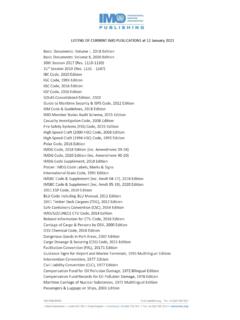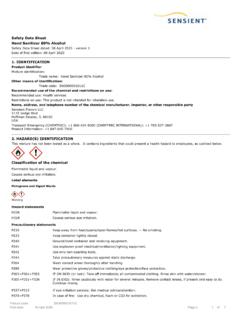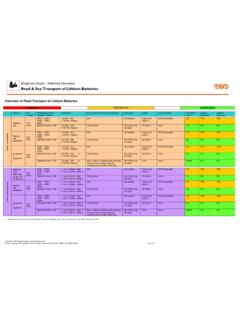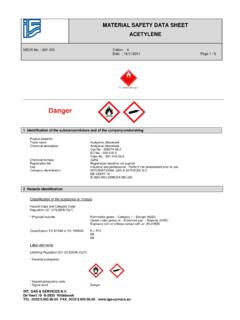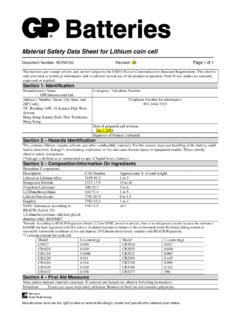Transcription of THE INTERNATIONAL MARITIME DANGEROUS GOODS …
1 THE INTERNATIONAL MARITIME DANGEROUS GOODS ( imdg ) CODEICHCA INTERNATIONAL BRIEFING PAMPHLET #39TH edition - September 2020 The voice of global cargo handlingProduced by:Sponsored INTERNATIONAL | imdg code ICHCA INTERNATIONAL BRIEFING PAMPHLET #3 9TH edition ICHCA INTERNATIONAL Limited2 INTRODUCTIONA bout this publicationThis publication is one of an extensive series of briefing pamphlets and other documents developed by the INTERNATIONAL Technical Panel of ICHCA INTERNATIONAL Ltd (ITP). The briefing pamphlet series is designed to provide all those involved in cargo handling, transport and related activities with practical advice and regulatory updates related to the safe handling and transport of goal of the briefing pamphlet series, and a prime focus for the work of ICHCA INTERNATIONAL and the ITP in general, is to foster a better understanding of how to reduce damage, injury and loss during handling and transport operations, safeguarding people, cargo, equipment and prepares its publications according to the information available at the time of publication.
2 This publication does not constitute professional advice, nor is it an exhaustive summary of the information available on the subject matter to which the publication should always be read in conjunction with the relevant national and INTERNATIONAL legislation and any applicable regulations, standards and codes of effort is made to ensure accuracy of the information, but neither ICHCA nor any member of the ITP is responsible for any loss, damage, costs or expenses incurred (whether or not in negligence) arising from reliance on or interpretation of the publication. The comments set out in this publication are not necessarily the views of ICHCA or any member of the briefing pamphlet necessarily represents a summary of some of the important aspects dealt with in the imdg code . For detailed advice it is essential to refer to the latest version of the code itself and read this in conjunction with the relevant national AdviceICHCA INTERNATIONAL provides a technical summary to its members of each set of changes made to the imdg code and also offers a technical advisory service to answer any queries that may arise.
3 For more information, contact the Head of ICHCA INTERNATIONAL , Richard Brough at membersICHCA INTERNATIONAL | imdg code ICHCA INTERNATIONAL BRIEFING PAMPHLET #3 9TH edition ICHCA INTERNATIONAL Limited3 TABLE OF CONTENTS Introduction 2 Chapter 1 Status and background 4 Chapter 2 Principles of the imdg code 5 Chapter 3 Layout of the imdg code 6 Chapter 4 Classification 7 Chapter 5 Marking, Labelling and Placarding 10 Chapter 6 Product containment 11 Chapter 7 Limited Quantities and Excepted Quantities 13 Chapter 8 Documentation 14 Chapter 9 Stowage and segregation 14 Chapter 10 Competent authorities 15 Appendices Contents table for the imdg code 2018 edition 16 About the author 18 About the publication sponsors 18 About ICHCA INTERNATIONAL and the Technical Panel 19 ICHCA INTERNATIONAL LtdRegistered address:F15 The Bloc38 Springfield WayAnlabyHullHU10 6 RJEmail All rights reserved.
4 No part of this publication may be reproduced or copied without ICHCA s prior written consent. Our thanks to member Exis Technologies for providing many of the photos and graphics included in this Published 19931st Revision 19952nd Revision 20003rd Revision 20034th Revision 20055th Revision 20076th Revision 20097th Revision 20118th Revision 20149th Revision 2020 ICHCA INTERNATIONAL Briefing Pamphlet #3 The INTERNATIONAL MARITIME DANGEROUS GOODS ( imdg ) CodeISBN: 978-1-85330-001-19th Revision 2020 ICHCA INTERNATIONAL | imdg code ICHCA INTERNATIONAL BRIEFING PAMPHLET #3 9TH edition ICHCA INTERNATIONAL Limited41 | STATUS AND BACKGROUNDThe INTERNATIONAL MARITIME Organization (IMO) is the specialised United Nations agency with responsibility for INTERNATIONAL MARITIME affairs. Like all United Nations agencies, the IMO is made up of Member States who are obliged to become contracting parties to IMO s various INTERNATIONAL conventions.
5 In addition to the Member States, there are a number of INTERNATIONAL organizations who are concerned with MARITIME issues and who have Non-Governmental Organization (NGO) status at IMO. ICHCA INTERNATIONAL Limited has such status at IMO DANGEROUS GOODS ConventionsThere are two INTERNATIONAL conventions produced by IMO which govern the transport of DANGEROUS SOLASThe INTERNATIONAL Convention for the Safety of Life at Sea, 1974 (1974 SOLAS Convention), as amended, Chapter VII of which deals with the safety aspects of the transport of DANGEROUS GOODS by MARPOLThe INTERNATIONAL Convention for the Prevention of Pollution from Ships as modified by the Protocol of 1978 (MARPOL 73/78), Chapter III of which deals with prevention of pollution arising from the transport of DANGEROUS GOODS by The imdg CodeAll IMO Member States are required to implement national legislation to address the transport of DANGEROUS GOODS , through their legal obligations under the SOLAS and MARPOL Conventions.
6 However, to assist them, the IMO has produced a detailed set of requirements covering the transport of packaged DANGEROUS GOODS by sea in a separate code ; the INTERNATIONAL MARITIME DANGEROUS GOODS ( imdg ) requirements of the imdg code are based upon the Model Regulations (known as the Orange Book ) produced by the United Nations Committee of Experts on the Transport of DANGEROUS GOODS in Geneva, together with a number of recommendations for good practice. The requirements of the imdg code are published in 2 volumes with an additional Supplement volume, which contains a number of individual IMO related AdoptionMost parts of the imdg code became mandatory on 1st January 2004, under the mandatory requirements of the SOLAS Convention. While most Member States have incorporated the requirements of the imdg code without further amendment into their national legislation, others have applied some different (usually more stringent) national requirements in addition to those of the imdg code .
7 When shipping DANGEROUS GOODS , it is important to be aware of any further restrictions or requirements, which may apply in a particular country, in addition to the imdg Shoreside TrainingTraining of shoreside personnel involved in packaged DANGEROUS GOODS shipments was made mandatory from 1 January 2010. Only paragraphs to (which deal with training content) remain FrequencyThe imdg code is updated on a two-yearly basis with each amendment valid for up to three years. Amendments overlap each other so that there is always a transition period for industry to make the necessary adjustments to the latest Year when single amendment only is valid Transition year when either amendment is valid38 - 1639 - 1840 - 20 ICHCA INTERNATIONAL | imdg code ICHCA INTERNATIONAL BRIEFING PAMPHLET #3 9TH edition ICHCA INTERNATIONAL Limited52 | PRINCIPLES OF THE imdg CODEA mendment 39-18, including a new edition of the supplement, was published on 1st January 2019 and became mandatory on 1st January work is undertaken by the Sub-Committee on Carriage of Cargoes and Containers (CCC)
8 In addition to incorporating amendments arising from the United Nations Committee of Experts in Geneva, the Sub-Committee also considers proposals for amendments prepared by IMO s Member States. All amendments must be approved by IMO s most senior technical committee, the MARITIME Safety The imdg code is based on an internationally agreed system which:1 Groups DANGEROUS GOODS together based on the hazards they present in transport (classification)2 Contains the DANGEROUS GOODS in packagings/tanks which are of appropriate strength and which will prevent the GOODS escaping3 Uses hazard warning labels and other identifying marks to identify DANGEROUS GOODS in transport4 Requires standard documentation to be provided when DANGEROUS GOODS are being transported5 Lays down principles for ensuring that incompatible DANGEROUS GOODS are kept apart6 Lays down principles for where to place DANGEROUS GOODS on board ship to ensure safe transport7 Provides emergency response advice for DANGEROUS GOODS involved in a fire or spillage on board shipCommittee (MSC), before they can be published in the next edition of the imdg code .
9 As a result of the two-yearly cycle of amendments, a completely new edition of the imdg code is published every two years. Following publication, an errata may be issued with additional changes or to correct any printing errors which may have is extremely important to ensure that the details on any errata issued are incorporated into the imdg code and taken into account at the appropriate INTERNATIONAL | imdg code ICHCA INTERNATIONAL BRIEFING PAMPHLET #3 9TH edition ICHCA INTERNATIONAL Limited63 | LAYOUT OF THE imdg FormatThe imdg code adopts a standard reference book format with an introduction, main contents, appendices and an index. Its layout has been harmonised with that of the United Nations Model Regulations (the Orange Book) which forms the basis of all INTERNATIONAL modal regulations covering the transport of DANGEROUS GOODS ( road, rail, inland waterway, air and sea).
10 Consequently, the multimodal shipper should be able to find the same information in the same part of the INTERNATIONAL regulations, no matter what form of transport is being used. DANGEROUS GOODS ListThe DANGEROUS GOODS List (DGL) is the core of the imdg code . This contains a list of all the DANGEROUS GOODS assigned under the United Nations system in numerical (UN Number) order (see below), together with their specific transport requirements in a coded VolumesThe code is presented in two main books, Volume 1 and Volume 2 with a third Supplement volume containing related IMO publications and IMO resolutions. It is necessary to use the first two volumes to obtain the required information when shipping DANGEROUS GOODS by Volume 1 Volume 1 contains Parts 1, 2, 4, 5, 6 and 7.
